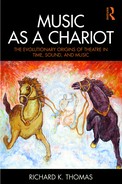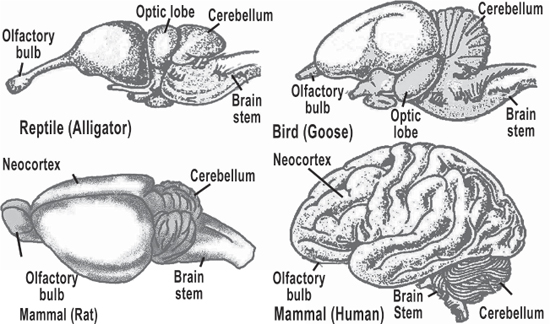Chapter 3
The Great Mystery of Time
Introduction: Babbling in Babelsberg
In acknowledging that sound is primarily a temporal form of perception, we suddenly find ourselves needing to broach the question, “What is time, anyway?” For most of the history of civilization we were content to consider that time was simply what we measured using seconds, minutes, hours, days, and years. That all changed when Einstein blew up our conventional understanding of the nature of time with his special theory of relativity. Einstein’s theory coincided with the Modernists, theatrical practitioners who experimented with the experience of time in the theatre. Could there be a relationship between the relativity of time and the theatrical experience? If so, how do we exploit it? This chapter will hope to answer the former question; the rest of the book the latter question.
In 2001 I was invited to lecture at the prestigious Babelsberg Film Studio in Babelsberg, Germany. At the time, we were just beginning to make the case that sound was an essential art form in theatre internationally, having made great progress in the United States, especially through organizations like the United States Institute for Theatre Technology (USITT). We had just started the Sound Working Group in the International Organization of Scenographers, Theatre Architects and Technicians (OISTAT) the year before to advance the understanding that theatre sound was really an art form and not just a technological discipline. Imagine that!
I embarked on a campaign to find “sound designers” in OISTAT’s member countries all over the world, and everywhere I went, I ran into the same reaction: “Sound design? We don’t have that here!” I would have to follow up with: “Well, do you have any composers who work in theatre?” That would ring a bell, and it would not be long before they would introduce me to prominent composers in their theatres. It was through this approach that I met some of the most amazing “sound designers” in the world—Vladimir Franz in the Czech Republic, Heiner Goebbels in Germany, Yossi Marchaim in Israel, and Igor Drevalev in Russia, among many more. Although many referred to themselves as composers, they immediately recognized the common objective that we all shared—providing the aural soundscape for the theatrical experience—and were often thrilled to meet someone else that shared their passion for providing sound scores for theatre. I distinctly remember being introduced to the great composer, Philip Glass. He asked me “What do you do?” I told him, “I’m a sound designer.” He smiled and replied, “So am I.”
In Babelsberg, I was asked to address the question, “Scenography: Close Bounded with Sound and Light Design?” Originally, the term “scenography” was largely used to describe a more holistic approach to the spatial design of a theatrical performance that included both scenery and costumes. The term comes from the Greek skēnographia, which means the “painting of scenery” (Merriam-Webster Online Dictionary 2015). The legendary scenographer Josef Svoboda certainly helped to popularize both the use of the term and the approach. Almost simultaneous to my lecture in Berlin, my friend Pamela Howard proposed this definition: “It is the seamless synthesis of space, text, research, art, actors, directors and spectators that contributes to an original creation” (Howard 2001, 16). Pamela’s reflection of the need to consider visual design in a much more holistic approach to theatre-making was very much on my mind when I was preparing my lecture for Babelsberg. I wanted my lecture to suggest that our understanding of scenography should naturally include the consideration of time, and if we were going to consider time, we would naturally need to consider its primary ally, sound.
Sound as scenography proved to be a very controversial proposal internationally. There was a fair number of member nations whose delegates thought that sound was a technical element of theatre, not an artistic element, and if included at all, belonged in the Technology Commission, not the Scenography Commission of OISTAT. I had been through this before in the United States, however. In 1984, I was invited by United Scenic Artists (USA) Local 350 to discuss inclusion of sound designers in the union (Thomas 1987). The discussion was heated and volatile, climaxing with a well-known scene designer arguing that sound should not be included in the union because “I paint scenery,” to which I replied, “I paint aural scenery.” At the time, it made no difference. Sound was perceived as a threat to the bottom line of visual designers. If sound were welcomed as a full member of the team, a fixed financial pie would have to be divided four ways, not three.
Fortunately for us, there was also quite a sizeable group that understood the artistic importance of theatre sound in OISTAT, and my invitation coincided with OISTAT’s Scenography Commission meetings in Berlin. This provided me an opportunity to engage in this discussion not only with the students, faculty and artists at the Babelsberg Film Studio, but also with the dubious element of the Scenography Commission. The subject “Scenography, Close Bounded with Sound and Light Design?” gave me the perfect opportunity to explore the similarities and differences between visual and sonic art.
The stakes were high, and I wanted to develop a more compelling argument about the relationship of sound to the experience of theatre. As I mentioned in Chapter 2, I had been using Einstein’s theory of relativity in my classes at Purdue to explain the relationship between space and time for many years. Since Einstein was German, I figured my German audience would appreciate my paying homage to their great theoretical physicist. There was only one problem: I still didn’t know very much about relativity.
As my interest was more aesthetic than mathematical, I went to Stephen Hawking’s outstanding but very non-technical book, A Brief History of Time, and eventually developed arguments about the role that sound plays in controlling the perception of time in theatre (Hawking 1988). The conclusions embellished upon in this book started with the kernel of those arguments that radically altered my fundamental understanding of the nature of theatre itself, an understanding that starts with exploring the unique nature of time, and how it is that we as humans came to have an awareness of it.
We start with the evolution of mammals, a higher order of animal with a larger brain that developed a conscious awareness that primitive tetrapods did not possess. Consciousness in mammalian evolution seems to have coincided with a prototypical development important to theatre: the evolution of dreaming. Dreams reveal inconsistencies in our perception of time that lead us into the discussion of the nature of time and its relation to theatre that I first presented at Babelsberg.
Incidentally, the lecture at Babelsberg went well. Mihai Nadin, the eminent scholar and researcher in such diverse fields as electrical engineering, aesthetics, semiotics and computing came by to listen to my lecture. Afterward, he took the time to carefully read my paper, and then invited me to his hotel to discuss it (Thomas 2001). Long story short, he expressed great enthusiasm for the ideas in the paper and encouraged me to continue to explore the subject. A lot of that exploration wound up in this book. Without Dr. Nadin’s encouragement, I very likely would not have continued to develop these ideas, and I owe a measure of gratitude to him for encouraging me to do so.
The Mammalian Invasion
The tetrapod brain was largely reflexive. It reacted to its environment instinctively and didn’t spend a whole lot of time thinking about things. Tetrapods couldn’t consciously “think”; they only possessed a very simple brain that included the basal ganglia (see Figure 5.17), which helped them to control movement, and a few other organs like our old friend the amygdala, the seat of emotional memory (New Scientist 2011). Keep in mind that all of this evolution is highly controversial as to exactly what happened when. The particulars are not so critical in this case, however. What we really need to know is that sometime about 300–350 million years ago, a new, larger brain evolved in some early tetrapods, a clade known as amniotes, from which birds and reptiles would also evolve (“clade” just means animals that evolved from a common ancestor). While birds are noted for their eloquent singing abilities, just a few of them have learned how to synchronize to a beat, the phenomenon referred to in Chapter 2 as entrainment, and made famous by the YouTube viral sensation Snowball (Patel et al. 2009). The third distinguished member of the amniote clade, the class of animals known as mammals, evolved about 250 million years ago during the rise of the dinosaurs at the beginning of the Jurassic period (Kielan-Jaworowska and Cifelli 2004, 1–2).
Mammals are distinct from reptiles and birds because they possess a more sophisticated neocortex or “new brain.”
There are six layers of tissues in the neocortex, compared to the four or fewer layers in the cerebra of birds and reptiles—a lot more room for a lot more connections.
The neocortex in mammals would eventually evolve to contain four main lobes: the frontal lobe, which is involved in decision making; the parietal lobe, which integrates sensory information from different parts of the body; the occipital lobe, the visual processing center of the brain; and the temporal lobe, which is all about time, as its name implies. The temporal lobe processes everything from the primary temporal perceptions of sound in the auditory cortex to the processing of time past: memory.
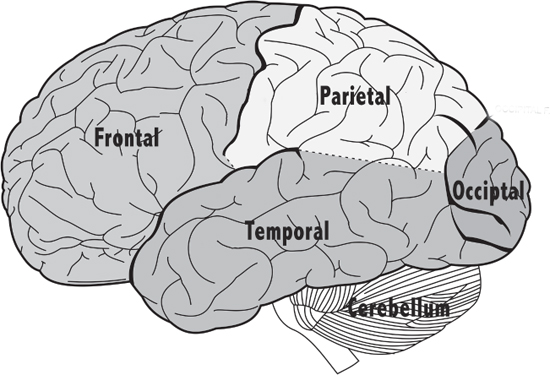
Figure 3.3 The lobes of the human brain.
Credit: From Gray, Henry. Anatomy of the Human Body. Lea and Febiger 1918, Figure 728. Adapted by Richard K. Thomas.
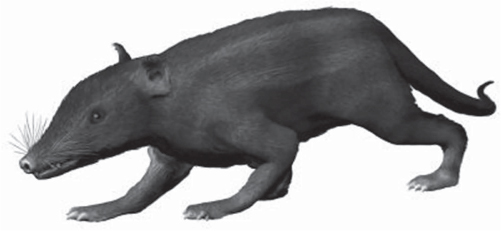
Credit: Drawing by Nobumichi Tamura.
Those pesky dinosaurs would cause all sorts of problems for early mammals, so they hid during the day and snuck around at night. The vast majority were shrew to mouse size.
Most of the mammals snacked on insects, unlike the dinosaurs who were large to extremely large and snacked on, well, little mammals, among other things (USGS 2001). But mammals were most likely warm-blooded, and this allowed them to forage nocturnally, and in places where their cold-blooded predators could not (Kielan-Jaworowska and Cifelli 2004, 4–6). Even today, almost half of mammalian species are nocturnal. Over time, their bodies would adapt to favor their nighttime activities.
Remembering that eyes are not so useful in the dark, it should come as no surprise that these early mammals developed a hearing mechanism keenly evolved to perceiving space, albeit still through the temporal lens of the ear. Slowly but surely, a couple more bones migrated from their lower jaw up to their ears, eventually connecting the tympani (eardrum) through two of those bones, the malleus (or hammer) and the incus (or anvil), to the existing stapes (or stirrup).
The stapes connected to the basilar membrane we met in Chapter 2 in an organ we now call the cochlea. In this way, all of those mechanical vibrations could finally be transduced to nerve impulses that went on to the brain for further processing—sort of like the old children’s song, “the leg bone’s connected to the knee bone” and so forth (“Dem Bones”). This was a huge deal, because none of the other amniotes, birds and reptiles, have this three-bone middle ear extravaganza. They are stuck with three jaw bones (dentary, angular and articular), and just the stapes in their middle ear (Masterton, Heffner and Ravizza 1969, 972–973).
These early mammals had spectacular ability to hear high frequencies with this new middle ear arrangement. The upper frequency hearing of mammals averages about 53 kHz! Curiously, humans and chimpanzees are the only mammals that don’t routinely hear above 20 kHz. By comparison, birds seem to only be able to hear up to about 12 kHz, and, as we mentioned earlier, reptiles, a very poor 1 kHz.
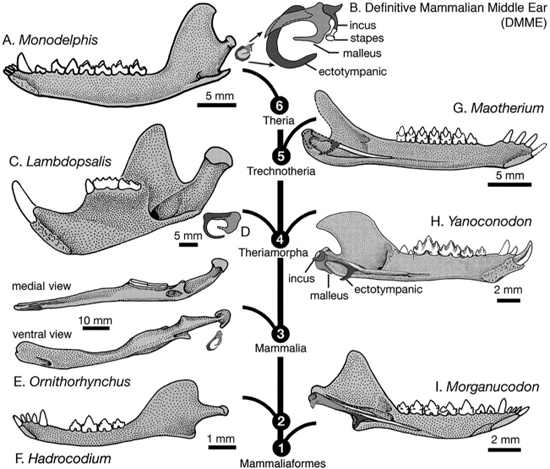
Credit: From: Ji, Qiang, Zhe-Xi Luo, Xingliao Zhang, and Chong-Xi Yuan, Li Xu. 2009. “Evolutionary Development of the Middle Ear in Mesozoic Therian Mammals.” Science 326 (5950), October 9: 278–281. Reprinted with Permission from AAAS. Figure 3D adapted by permission from Macmillan Publishers Ltd: Nature. Meng, Jin, and André R. Wyss. 1995. “Monotreme Affinities and Low-Frequency Hearing Suggested by Multituberculate Ear.” Nature 377 (6545) 141–144. Copyright 1995.
Why would high frequency hearing be an evolutionary advantage? As we discussed in Chapter 2, animals with two ears determine location based on time differences between when the sound arrives at each ear and how loud the sound is at each ear. Since primitive mammalian heads were so small, it would be very hard for them to localize based on when, because the time-travel differences between the two ears were so small. But the higher the frequency, the easier it is for the head to absorb sound, creating intensity differences at each ear when a sound does not originate directly in front of or behind an animal. Small mammals could use intensity differences at each ear to localize sounds, but only at higher frequencies. Over time, many of these mammals even lost their ability to hear low frequencies—even below 1 kHz, a possible indication that hearing low frequencies was not as evolutionarily critical as localizing high frequencies for these nocturnal foragers.
Another useful advantage of this mammalian middle ear was its increased sensitivity to quiet sounds—20 dB or more above that of reptiles. Don’t fret too much about this “dB” thing. Just know that most humans consider a change of 10 dB to be about twice as loud, or twice as sensitive, so 20 dB would be roughly four times more sensitive. That 20 dB difference would really give these early mammals an advantage in sensing predators and finding prey.
Hearing was not the most important sense to these early mammals, however. The sense of smell, developed in a sense organ called the olfactory bulb (see Figure 3.2), dominated early mammalian brains, not sight or sound. In contrast, the four different color sensing cone cells in the primitive mammalian eye were somewhat useless in seeing at night. And so, 150–200 million years ago, most mammals seem to have lost two of the four cone cells (Davies, Collin and Hunt, 3137). Curiously during this period, the nose and the ears may have become more important in sensing the spatial characteristics of a primitive mammal’s environment than eyes.
As time went on, these primarily nocturnal mammals also developed a much more sophisticated neocortex. It included specialized areas that improved their sense of touch, sight and vision. Most importantly, the continuously evolving neocortex developed areas for such conscious activities as decision making. One such area was the auditory cortex, which developed connections to the basilar membrane, and allowed mammals to consciously perceive sounds and make decisions about how to act upon them (Molnar et al. 2014, 128).
The six layers of the human neocortex we mentioned earlier consist of what we call “gray matter”: six layers of neurons compared to the single layer cortex of reptiles.
This gray matter is folded up in the human brain to allow more of it to fit in our brains! This is the part we most familiarly see when we look at pictures of the brain. Underneath this “gray matter,” there is “white matter”: millions of filaments connecting vertical “columns” of neurons in the six layers to other parts of the brain (Jourdain 1997, 52). More layers allow much more sophisticated distribution of sensory information to other layers, and then to other parts of the brain. Here we see additional evidence of the brain using space to perceive time, as the frequencies that localized along the basilar membrane also localized along the primary cortex (remember that frequency is a measure of cycles per second). This white matter also transmits information about when the sound happened, how loud it was (intensity) and how long it lasts (duration). This arrangement, unique to mammals, proved extremely useful, and perhaps contributed to an ever-enlarging brain (Rakic 2009). Over the next 100 million years, the size and number of areas in mammalian brains devoted to perception of sight and sound would continue to increase. Mammals would eventually develop brains ten times the size of reptiles the same size, and as mammalian brains grew in size relative to body weight, so did the number of neurons and their interconnections. This led to a much better ability to process sensory information, solve problems, and ultimately live a more complex and adaptive life (Northcutt 2002, 750).
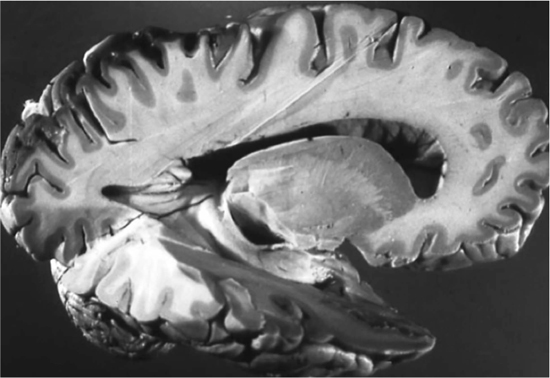
Figure 3.6 Dissected view of right half of brain shows gray matter and white matter.
Credit: © John A Beal, PhD Dep’t. of Cellular Biology & Anatomy, Louisiana State University Health Sciences Center Shreveport in “Anatomy of the Human Brain.” Heal National Digital Library, Publication ID 274, December 9, 2005. Accessed July 21, 2017. http://web.archive.org/web/20110514023714/www.healcentral.org/healapp/showMetadata?metadataId=40566. CC-BY-2.5. https://creativecommons.org/licenses/by/2.5/deed.en. Adapted by Richard K. Thomas.
The superiority of ears over eyes in the perception of space would be short-lived. A mass extinction event 66,038,000 years ago would wipe out the dinosaurs, and mammals would return to the sunlit world, eventually developing an additional cone cell type that allowed them to perceive the world in color (Renne et al. 2013, 684). Our ears would never lose their extraordinary ability to use time to perceive spatial positioning, and to this day provide us with a fascinating spatial perspective of the outside world. But the eyes once again emerged with a superior ability to perceive space in the mammalian environment. About that time, however, the unique mechanisms that early mammals developed to perceive temporal relationships would take an amazing turn toward providing us with a surprising understanding of the universe that would have major implications for sound designers and composers.
We Are Such Stuff as Dreams Are Made Of …
Sometime during this long evolution of mammals, or just before, an extraordinary phenomenon evolved that has tremendous implications for our story: the expanding neocortex provided new opportunities for anticipating problems and imagining solutions. According to some theories, one approach to problem solving was the development of a “threat simulation system,” called dreaming. Dreaming allowed animals to test possible solutions (Revonsuo 2000, 877). Whether reptiles dream or not is debated, but highly doubted (Siegel 1998). Yet even Aristotle observed that horses, dogs, oxen, sheep and goats all dream. Researchers have measured and verified that rats, who are further up our evolutionary ladder, also dream (Goldman 2014). Rats diverged from our branch of the mammalian tree about 90 million years ago. We both evolved, however, in a special subdivision of mammals called Placentalia. The Placentalia subdivision means pretty much what you’d think it means: mothers who carry their fetuses in their uterus nourished by a placenta (Kaas 2011). We are pretty sure, then, that all “placental” mammals dream, as they have the same basic neural structures that are important to sleeping and dreaming (Bekoff 2012, 16).
Antti Revonsuo, a Finnish neuroscientist, defines dreaming as a “subjective experience during sleep, consisting of complex and organized images that show temporal progression.” In other words, we subjectively experience space and time in dreams (Revonsuo 2000, 878). Dreams are important to us because they offer one of the most primeval possibilities of proto-theatre activity in animals. Nietzsche suggested an origin of theatre in dreams (Nietzsche 1872, 11; Jourdain 1997). Freud characterized dreams as dramatizing an idea, and spoke often about dreams and theatre as analogous in his book, The Interpretation of Dreams (Freud 1913, 23). Eli Rozik, in his book, The Roots of Theatre, also considers theatre and dreams to be analogous, one major difference being that theatre is “communicative” (Rozik 2002, 250). Dreams provide us an alternative, subjective way of experiencing time and space, in a similar manner to theatre, so it is important that we gain a better understanding of how we perceive space and time in dreams. Later we will find a potentially similar type of perception in theatre.
Dreaming works in an almost opposite way than the normal transmission of sound and light waves through the eyes and ears to the brain for processing. In dreaming, the brain itself generates images and sounds and sends those to the same parts of the brain for processing as would have occurred if they had been transmitted through the eyes and ears. We know this because we can now “look” at the brain during periods of sleep and wake with electroencephalography (EEG), which measures voltage fluctuations of neurons in the brain; positron emission tomography (PET), which uses X-rays to observe metabolic processes; and functional magnetic resonance imaging (fMRI), which measures brain activity associated with blood flow. In short, we now can tell fairly precisely, where spatially and when temporally, neurons fire in the brain. We can find a lot out about how the brain works that way. Once we know what each part of the brain does, we can explore which parts of the brain are doing something and what they are doing while we are dreaming. And it turns out neurons fire in many of the same places during dreams that they fire when we are awake, including our processing centers for sight and sound, the occipital lobe and the temporal lobe, respectively. In dreaming we really see, hear, touch, taste and smell (Nir and Tononi 2010, 89).
As twenty-first-century humans with allegedly superior brains, we recognize that our perceptions of unusual images in odd times and spaces are dreams. Imagine, though, how a primeval rodent must have perceived dreams tens of millions of years ago. It would most likely perceive an extraordinary similarity to its waking world, because dreams are like that. Dreams present an experience very similar to the waking world, and dreamers feel like they are participating in that experience. For all practical purposes, the rodent’s sight, sound, touch, taste and smell would all seemed to have been functioning normally. The rodent would have perceived the dream world to predominantly conform to its waking world, but would probably have felt much more emotionally stimulated—oh yes, our old friend the amygdala seems to often get quite hyperactive during dreaming, as do other older elements of a rodent’s more highly evolved limbic system. As we introduced in Chapter 2, the limbic system consists of the part of the brain responsible for emotion, flight-or-flight behavior, memory and smell. It includes the hippocampus, which also stores and retrieves memories (see Figure 5.9). In short, as far as the rat was concerned, a dream must have been reality. Of course, there’s no way to prove such a notion, but we do know that primitive human cultures considered dreams to be a form of reality (Lincoln 2003, 23, 27–30; Obringer 2016). It’s hard not to imagine that primitive animals with even less cognitive ability to tell the difference between the dream world and the waking world would imagine a dream to be anything other than reality.
Another aspect of dreaming that seems like it would increase a primitive animal’s perception of dreams as reality, is that most dreams are forgotten almost immediately upon waking. Curiously and conversely, we tend to forget a lot of facts about our waking world while we are dreaming, too. For example, we forget the simple fact that some of the characters we encounter in dreams are deceased. And yet, in our dreams we still accept the deceased characters as living without question. We accept activities that are impossible in the waking world, like flying, again, without question. It’s not hard to imagine that for a primitive mind, what happened during a dream and while awake were just two realities, some characteristics of one forgotten as soon as the other replaced the first.
Even while accepting the dream world as real, there can be no doubt that time does not function in the same manner as it does in the waking world. In our dreams, we often suddenly change location spontaneously without question. Our perception of time in dreams can be quite different from that of our waking self. For many, time perception in dreaming can be exactly the same as in waking (Bolz 2009). For some, dream events seem to take longer than in real life (Erlacher and Schredl 2004; Erlacher et al. 2014). For others, time is much compressed, and many dreamers report lengthy dreams that pass in just a few minutes of waking time (Hancock 2010, 77). There is even some interesting evidence that, for some, time can run backward compared to events happening in our waking world! (Joseph 2012).
Our unique perception of time during sleep has been attributed to studies that show that the part of the brain (the dorsolateral prefrontal cortex; sort of behind the forehead, if you must know) responsible for the “temporal order of information retrieval” is relatively deactivated during REM1 sleep and dreaming (Muzur, Pace and Hobson 2002, 477, 479). Meanwhile, other regions of our brain such as the hippocampus and our old friend, the amygdala, both keepers of memories, generate images in what can often be bizarre orders and timing. We seem to have no control over how time unfolds in a dream, because that area is not activated during REM sleep (Nir and Tononi 2010, 89).2 It seems like the individual’s perception of time, and not the common referencing to a waking clock in the laboratory, is more important in dreaming. In dreams associated with REM sleep then, our perception of time as we know it in waking life pretty much goes out the window. In a dream, unencumbered by our waking physical reality, our mind is free to construct its own passage of time, and this can be quite different from the passage of time in our waking world. And this perception of time occurs in what is typically a rather highly charged emotional environment—just like in music and theatre.
The Relativity of Time
A photon walks into a bar. The bartender takes one look at the photon and says, “you’re new around these parts, aren’t ya?” The photon says “yup,” so the bartender asks him, “where ya from?” “I just got here from Gliese 832c,” says the photon. “Gliese 832c?” says the bartender. “That’s the closest planet to earth that might support life as we know it, but it’s still 100,000 light years away. So I guess you’re old enough to be in a bar. But I have to check your license anyway.” So the photon hands its license to the bartender. The bartender takes one look at the photon’s license and throws the photon out of the bar.

Credit: Photo by Sandstein.
Why?
Albert Einstein was working at the Berne, Switzerland, patent office in 1905 when he published his four papers that would forever change the way we think about time (Galison 2000, 368, 386). One of Einstein’s famous “thought experiments” goes like this. Imagine that you are moving away from the clock tower in downtown Berne.
As you move away, the light must catch up with you. If you can move fast enough, the light will never catch up with you. Einstein proposed the speed at which the light would not catch up with you to be 186,300 miles per second. It is kind of the ultimate speed limit of the universe—nothing can travel faster than that speed. As we approach that speed, the clock would appear to slow down. If we were able to attain that speed, the clock would stop altogether.
Once we start thinking about space and time as waves whose information we receive via light and sound, Einstein’s theory of relativity starts to tell us something even more interesting about time: it’s not what we think it is!
To understand relativity, consider a man who throws a ball on a train (Nova Online 2000).
Another man stands on the side of the track watching. The speed of the ball varies with the speed of the train. Let’s say the train is traveling at 30 miles per hour, and the man on the train is throwing the ball at 20 miles an hour. To the man on the ground, the ball is traveling at 50 miles an hour. To the man on the train, the ball is only traveling at 20 miles per hour. You argue, of course, that we all know the ball is really traveling at 50 miles per hour; the guy on the train is just mistaken. I beg to differ, because keep in mind that the earth spins at about 1,000 miles an hour around its center, and that we are rotating around the sun about 67,000 miles an hour, and our solar system is spinning around our galaxy at 490,000 miles per hour, so remind me again how fast is this ball moving? 558,050 miles per hour (Scientific American 1998)? It depends. Without a frame of reference, questions about motion and time are meaningless.
Now consider the same situation, but instead of throwing the ball, the man turns on a flashlight.
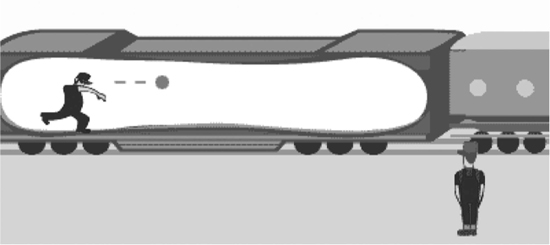
Figure 3.8 Man throwing ball on train.
Credit: From Time Travel: Think Like Einstein. www.pbs.org/wgbh/nova/time/think02.html © 2010–2017 WGBH Educational Foundation.
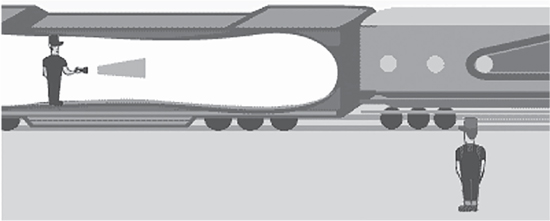
Figure 3.9 Man turning on flashlight on train.
Credit: From Time Travel: Think Like Einstein. www.pbs.org/wgbh/nova/time/think02.html © 2010–2017 WGBH Educational Foundation.
No matter how fast the train travels, light from the flashlight still travels at 186,300 miles per second. To the guy on the train, light is traveling at 186,300 miles per second. To the guy on the ground, light is traveling at 186,300 miles per second. Anywhere you measure from any point in the universe, the light is traveling at 186,300 miles per second. It doesn’t make a difference whether you compare it to anyone else; it’s still traveling at 186,300 miles per second. The speed of light is a constant. When we say speed of light, c isn’t just the speed of light; c is the maximum speed of everything; consider it to be the speed limit of the universe.
Nothing goes faster! Light just happens to go that fast because it is transmitted by the massless photon.
Einstein observed that two different observers moving relative to each other, each measuring the speed of the same blob of light relative to himself, will both get c, even if the relative motion is in the same direction as the motion of the blob of light. If velocity is equal to the distance in time (v = d/t), and both the distance the light travels and the velocity of the light are the same for both observers, then time must be different for both observers! Time must be different! Einstein’s theory of relativity doesn’t say, “no, it’s the same time, they are just perceiving it differently”; Einstein’s theory says that time itself is different for both observers. This is a monumental concept.
Imagine that you are able to get on a rocket ship that can travel really, really fast—close to the speed of light. You blast off from earth, and you travel out into the universe close to the speed of light. Then you return to earth. Surprise! Everyone has aged considerably, but for you, time has proceeded normally. Your children now appear to be much older than you! Even their grandchildren might look older than you, depending on how fast you traveled and how long you were gone!
So why did the bartender throw the photon out of the bar? The bartender threw the photon out of the bar because the photon’s license said that the photon was born that day. From the bartender’s perspective, it took the photon 100,000 light years for the photon to reach the earth. From the photon’s perspective, it arrived at the same instant it left Gliese 832c.3 This is the same as Einstein’s “thought experiment”: if the photon looked back at a clock on Gliese 832c, the clock would not change because the photon was traveling at the speed of light!
Understanding the relativity of time helps us to understand our perception of time in dreams, especially when it doesn’t conform to the way our clocks keep time in our waking world. In dreams, we no longer share the same frame of reference (e.g., an atomic clock that everyone mutually agrees is the current time). In our dreams, the mind creates its own frame of reference; it decides what our internal clock will be, mostly determined by the rate and order of images and memories it sends to our occipital and temporal lobes. And that time can be quite different from our waking clocks. Even in waking life we know this to be true. Everyone experiences time differently. One student gets involved in one of my lectures and the whole hour seems to pass by quickly. Another student (OK, realistically, more than one) finds my lecture to be nothing but a big bore, and time passes interminably slow, or they fall asleep, so I throw an eraser at them (not really). Theoretical physicist Sean Carroll suggested in his address at the 2011 International Conference on the nature of time that the time measured by extremely accurate clocks in our waking world isn’t “as important as the time measured by our internal rhythms and the accumulation of memories” (Carroll 2011). That’s relativity.
In our dreams, we experience a “reality” quite different than our waking world, complete with its own definition of how time passes and operates, and we do not question it. We gain a little bit of the same experience when we set our DVR to record the ball game to watch later. Well past the actual event, we watch the game, and before too long, we start getting into the game. We celebrate a great play, we get anxious about what will happen next, we root for our team as if they were playing in the present moment, all of this as if the game was occurring in the present, not in the past. At some point, the conscious part of our waking brain suddenly realizes that we have left the present waking moment, and have been experiencing as real the past time frame of the game.
In a similar way, we experience the same shift in our perception of reality when we are transported by a well-made theatre production. When we become immersed in theatre, our experience is very “dreamlike” because we experience the world and actions of the play as a present reality, our emotions are typically much stronger than in our average daily world, we don’t exercise control over the story even though we feel as if we are an active participant (through the cathartic experience of identifying with the protagonist, which we will take up later in the book, especially Chapters 10 and 12). We also lose conscious awareness of how time is passing in the “waking world” outside of the dramatic context of the play, and time frames of reference can shift effortlessly, moving both forward and back in time, without our disengaging from the scene. In short, we experience the sensation of “being there” in the dramatic moment of the play. It is this fundamental sense of “being there” that makes theatre such a special form of human perception.
Our theatre experience isn’t totally immersive like it is in typical dreams either, though. Rather, it is more like a dream condition known as “lucid dreaming,” in which the dreamer becomes aware of the fact that they are dreaming.4 One of the interesting properties of experiencing live theatre is that we can simultaneously be immersed and present in the dramatic world, experiencing the dream world of the performers, and yet still retain a waking consciousness that allows us to consider what that dream world means to us (or any other distractions, for that matter!).
I remember the first time I ever saw a live play. It was in my senior year in high school. My private Catholic school had shut down after my junior year, and I was forced to transfer to a much larger public school for my senior year, L’Anse Creuse High School in Mount Clemens, Michigan. I had never seen a live play before. One day our English teacher, Ms. McCarthy, who also served as the school’s drama teacher, took our class down to the gym to watch a dress rehearsal of an upcoming play, an old chestnut called The Curious Savage. I was clearly not expecting my life to be forever changed that day, but it was. Sometime during the performance, I got involved, transported, and I suddenly started experiencing the world of the play as if I was in that world. This shocked my waking mind when I realized what was happening. These were my friends from English class; I recognized them! But there they were onstage, pretending to be other people, and I was believing their performance to the point that I stopped experiencing the time of the waking world of English class, and started experiencing the time of these five crazy residents in a sanatorium called The Cloisters (the setting of The Curious Savage). I had already been awarded a math scholarship to attend Michigan State University, but my experience with The Curious Savage was so profound that I decided then and there to change my major to theatre. I’ve never looked back. Theatre can do that to a person.
Back at my 2001 lecture in Babelsberg, Mihai Nadin commented on my thoughts about the relationship between Einstein’s theory of relativity and the nature of our experience of time in theatre. “It’s true,” he said. I was never able to find out from him exactly what he meant by that. Was the time we thought passed in a play, time passed in our lives? Was it time passed without the disadvantage of our corporeal bodies aging because we had disengaged from the corporeal world? Indeed, the experience of the drama was now part of our memory, and that memory certainly included our experience of how long the story lasted—which is typically much different from how long the play lasted in waking time. At first, I thought he must have meant what he said metaphorically, but as time has gone on, I’ve become more and more convinced that the relativity of time to the individual in our perception of theatre is very real. Einstein hinted at this very much one day when he told his secretary how to explain relativity to reporters and laypersons: “An hour sitting with a pretty girl on a park bench passes like a minute, but a minute sitting on a hot stove seems like an hour” (Calaprice 2005, 247).
In other words, something happens in experiencing a play that fundamentally alters our perception of the external world, that makes us believe that this altered world is unfolding before our very eyes and ears. It is a world of exaggerated emotions in which time does not conform to our waking world, and these two features somehow seem to be related to our being transported into this dream world in the first place. We have already seen that the primary way that we receive information about the world around us is through electromagnetic waves traveling in space, and mechanical waves traveling through mass. We have witnessed the evolution of eyes and ears in our human lineage right up through mammals to perceive those electromagnetic and mechanical waves, respectively. We have followed the evolution of the human brain to allow us to consciously process those waves in ever more perceptive ways. One of the mechanisms of the conscious brain for imagining our world is dreaming, and we now see that the brain itself can generate images that we perceive in a very similar way to how we perceive electromagnetic and mechanical waves from the outside world. Imagination and its close friend dreaming have led us to understand how our experience of the external world is fundamentally altered by our perception of time, which presents a unique experience to each of us because we now know that time itself is unique to each individual. Now, if there was just some way that we could manipulate our perception of time and emotional state to transport us into these dreamlike worlds of the theatre….
Ten Questions
- What characteristic of early mammals caused them to develop a much more sophisticated middle ear?
- How do most mammals differ from humans in their ability to sense frequency and loudness?
- What does the neocortex allow mammals to do that reptiles can’t do?
- What happened to cause the early mammal eyes to regain color vision and once again to achieve superiority over the ears in the perception of space?
- How does dreaming differ from waking, in regards to seeing and hearing in mammals? How does it differ?
- Give four reasons why a primitive mammalian rodent would perceive its dream world as reality.
- Why is “time so out of joint” in many dreams?
- How is it that time is relative to each individual?
- Why is it that an atomic clock might not be a very good indicator of the passage of time for an individual, and what does this have to do with theatre and dreams?
- Name five ways in which our perception of time in theatre resembles our perception of time in dreams.
Things to Share
- Start a dream diary for a week, and keep it on your nightstand where you can readily access it after you dream. If possible, record as many details as you can remember of your dreams immediately after you wake from each dream (you will typically find that you have your dreams early in the morning during REM sleep, and most people have between about three and five dreams each night). If it is not possible to record them immediately upon waking, record them first thing in the morning (if you do this, you will find that you forget most of them). Pay special attention to how you perceive space and time in your dreams. Did your location change at all during the dream? Did you have features of two or more separate locations merged together into a single location? Was time continuous in your dream, or were there gaps? Did different time periods co-exist in your dream; for example, did elements from your childhood combine with elements from your adult life? Did the dream appear to take the same, more or less time than the length of your dream in waking time (this is easier to judge if you have already awakened, and then fallen back to sleep)? Tell us about the most significant discoveries you made in your dreams, and provide examples about the unique way time and space works. If possible, draw a parallel to how time and space work in a scene in a play or movie you have seen. For the really ambitious and curious, develop the ability to lucid dream so you can manipulate time and space to your own liking, and develop your own ability to tell incredible stories (many websites have a wealth of information about how to develop this ability).
- Find a movie that has won an Academy Award for sound. Pick a movie that you love and wouldn’t mind seeing again. Now get hold of the movie (perhaps buy it, because you can use it for other projects in this class, or rent it, or even check it out from your local library). Watch it with an eye toward sound color, the particular combination of frequencies unfolding in time that create the unique timbre of each sound. Find what you consider to be an amazing sound. Tell us about what you find so amazing about it, and whether you think the sounds would be better received by the lateral line of fish (very low frequencies below 200 Hz, bass), reptiles (middle frequencies between 200 Hz and about 1,000 Hz, midrange), or mammals (high frequencies above 1,000 Hz). Explain how you think the sound affects us emotionally. Bring at least two examples with you in case someone uses your first example.
- Find a movie that has won an Academy Award for sound. Pick a movie that you love and wouldn’t mind seeing again. Now get hold of the movie (perhaps buy it, because you can use it for other projects in this class, or rent it, or even check it out from your local library). Watch it with an eye toward sound localization, the particular spatial characteristics of sound and music. Find what you consider to be an amazing use of space. Tell us about what you find so amazing about it, and whether you think the space is being used to localize the sound, or to further “immerse” us in the scene by recreating a specific acoustic environment. Explain how you think the sound affects us emotionally. Bring at least two examples with you in case someone uses your first example.
Notes
1Rapid eye movement, a phase of sleep characterized by rapid eye movement and long associated with vivid dreaming.
2We should note that studying the phenomenon of human perception of time in dreams appears to be a pretty hard thing to do, which may explain why there is so little hard research, and why that research is so inconclusive. Nevertheless, there is a wealth of anecdotal evidence out there about how our perception of time in dreams does not conform to our waking time references, and virtually all of my students and my own experience confirm a very different perception of time in dreams than in waking life. See the references in these last two paragraphs for a small sampling of examples.
3Keep in mind that we aren’t taking into account the effect of gravity on time, which is a whole other problem! We are also being silly, of course, because the act of the bartender “seeing” the photon would involve his eye absorbing the photon, unless they could get the whole conversation/license check thing out of the way very very quickly!
4Experienced lucid dreamers even develop the ability to control their dreams, a condition much more akin to playing a video game, in which the player becomes the protagonist of the game.
Bibliography
Bekoff, Marc. 2012. “Do Animals Dream? Science Shows of Course They Do, Rats Too.” December 4. Accessed February 10, 2016. www.psychologytoday.com/blog/animal-emotions/201212/do-animals-dream-science-shows-course-they-do-rats-too.
Bolz, Barbara. 2009. “How Time Passes in Dreams.” September 9. Accessed February 11, 2016. http://indianapublicmedia.org/amomentofscience/time-passes-dreams/.
Calaprice, Alice. 2005. The New Quotable Einstein. Princeton, NJ: Princeton University Press.
Carroll, Sean. 2011. “Ten Things Everyone Should Know About Time.” September 1. Accessed February 15, 2016. http://blogs.discovermagazine.com/cosmicvariance/2011/09/01/ten-things-everyone-should-know-about-time/#.VsI99cdTLct.
Davies, Wayne I. L., Shaun P. Collin, and David Hunt. 2012. “Molecular Ecology and Adaptation of Visual Photopigments in Craniates.” Molecular Biology Vol. 21, 3121-3158.
Erlacher, Daniel, Melanie Schädlich, Tadas Stumbrys, and Michael Schredl. 2014. “Time for Actions in Lucid Dreams: Effects of Task Modality, Length, and Complexity.” Frontiers in Psychology 4: 1–12.
Erlacher, Daniel, and Michael Schredl. 2004. “Time Required for Motor Activity in Lucid Dreams.” Perceptual and Motor Skills 99 (3 suppl): 1239–1242.
Freud, Sigmund. 1913. The Interpretation of Dreams. New York: Palgrave Macmillan.
Galison, Peter. 2000. “Einstein’s Clocks: The Place of Time.” University of Chicago Press 26 (2): 355–389.
Goldman, Jason G. 2014. “What Do Animals Dream About.” April 25. Accessed February 10, 2016. www.bbc.com/future/story/20140425-what-do-animals-dream-about.
Hancock, Peter A. 2010. “The Battle for Time in the Brain.” In Time: Limits and Constraints, edited by Jo Alyson Parker, Paul A. Harris, and Christian Steineck, 76–87. Pacific Grove, CA: International Society of the Study of Time.
Hawking, Stephen. 1988. A Brief History of Time. New York: Bantam Books.
Howard, Pamela. 2001. “What Is Scenography? or What’s in a Name.” Theatre Design and Technology (United States Institute for Theatre Technology) 37 (3): 13–16.
Joseph, Rhawn. 2012. “Dreaming and Dream Sleep.” Accessed February 15, 2016. http://brainmind.com/Dreaming.html.
Jourdain, Robert. 1997. Music, the Brain and Ectasy. New York: William Morrow.
Kaas, Jon H. 2011. “Reconstructing the Areal Organization of the Neocortex of the First Mammals.” Brain, Behavior and Evolution 78 (1): 7–21.
Kielan-Jaworowska, Zofia, and Richard L. Cifelli. 2004. Mammals from the Age of Dinosaurs. New York: Columbia University Press.
Lincoln, Jackson Steward. 2003. The Dream in Native American and Other Primitive Cultures. Mineola, NY: Dover.
Masterton, Bruce, Henry Heffner, and Richard Ravizza. 1969. “The Evolution of Human Hearing.” The Journal of the Acoustic Society of America 45 (4): 966–985.
Merriam-Webster Online Dictionary. 2015. “Scenography.” Accessed February 2, 2016. www.merriam-webster.com/dictionary/scenography.
Molnar, Zoltá, Jon H. Kaas, Juan A. de Carlos, Robert F. Hevner, Ed Lein, and Pavel Nemec. 2014. “Evolution and Development of the Mammalian Cerebral Cortex.” Brain, Behavior and Evolution 83 (2): 126–139.
Muzur, Amir, Edward F. Pace, and J. Allan Hobson. 2002. “The Prefrontal Cortex in Sleep.” Trends in Cognitive Science 6 (1): 475–481.
New Scientist. 2011. “A Brief History of the Brain.” September 21. Accessed April 12, 2016. www.newscientist.com/article/mg21128311-800-a-brief-history-of-the-brain/.
Nietzsche, Friedrich. 1872. The Birth of Tragedy Out of the Spirit of Music. Translated by Ian Johnston. Leipzig: Verlag Von E.W. Fritzsch.
Nir, Yuval, and Giulio Tononi. 2010. “Dreaming and the Brain: From Phenomenology to Neurophysiology.” Trends in Cognitive Science 14 (2): 88–100.
Northcutt, Glenn R. 2002. “Understanding Vertebrate Brain Evolution.” Integrative and Comparative Biology 42 (4): 743–756.
Nova Online. 2000. “Think Like Einstein.” November. Accessed February 15, 2016. www.pbs.org/wgbh/nova/time/think.html.
Obringer, Lee Ann. 2016. “How Dreams Work.” Accessed February 10, 2016. http://science.howstuffworks.com/life/inside-the-mind/human-brain/dream3.htm/printable.
Patel, Aniruddh D., John R. Iverson, Micah R. Bregman, and Irena Schulz. 2009. “Experimental Evidence for Synchronization to a Musical Beat in a Nonhuman Animal.” Current Biology 19 (10): 827–830.
Rakic, Pasko. 2009. “Evolution of the Neocortex: A Perspective From Developmental Biology.” Neuroscience 10 (10): 724–735.
Renne, Paul R., Alan L. Deino, Frederik J. Hilgen, Klaudia F. Kuiper, Darren F. Mark, William S. Mitchell III, Leah E. Morgan, Roland Mundil, and Jan Smit. 2013. “Time Scales of Critical Events Around the Cretaceous-Paleogene Boundary.” Science 339 (6120): 684–687.
Revonsuo, Antti. 2000. “The Reinterpretation of Dreams: An Evolutionary Hypothesis of the Function of Dreaming.” Behavioral and Brain Sciences 23 (6): 877–901.
Rozik, Eli. 2002. The Roots of Theatre. Iowa City: University of Iowa Press.
Scientific American. 1998. “How Fast Is the Earth Moving.” October 26. Accessed February 15, 2016. www.scientificamerican.com/article/how-fast-is-the-earth-mov/.
Siegel, Jerome M. 1998. “The Evolution of REM Sleep.” In Handbook of Behavioral State Control, edited by Ralph Lydic and Helen A. Baghdoyan, 7.7–7.8. Boca Raton: CRC Press.
Thomas, Richard. 1987. “The Need for Union Representation for Theatre Sound Designers.” Richmond Sound Design Ltd. January. Accessed February 2, 2016. www.richmondsounddesign.com/docs/need-for-union-representation-fall-1987-small.pdf.
———. 2001. “Dramatic Space and Time.” May 9. Accessed February 2, 2016. www.richmondsounddesign.com/docs/dramatic-space.doc.
USGS. 2001. “What Did Dinosaurs Eat?” May 17. Accessed February 6, 2016. http://pubs.usgs.gov/gip/dinosaurs/food.html.
